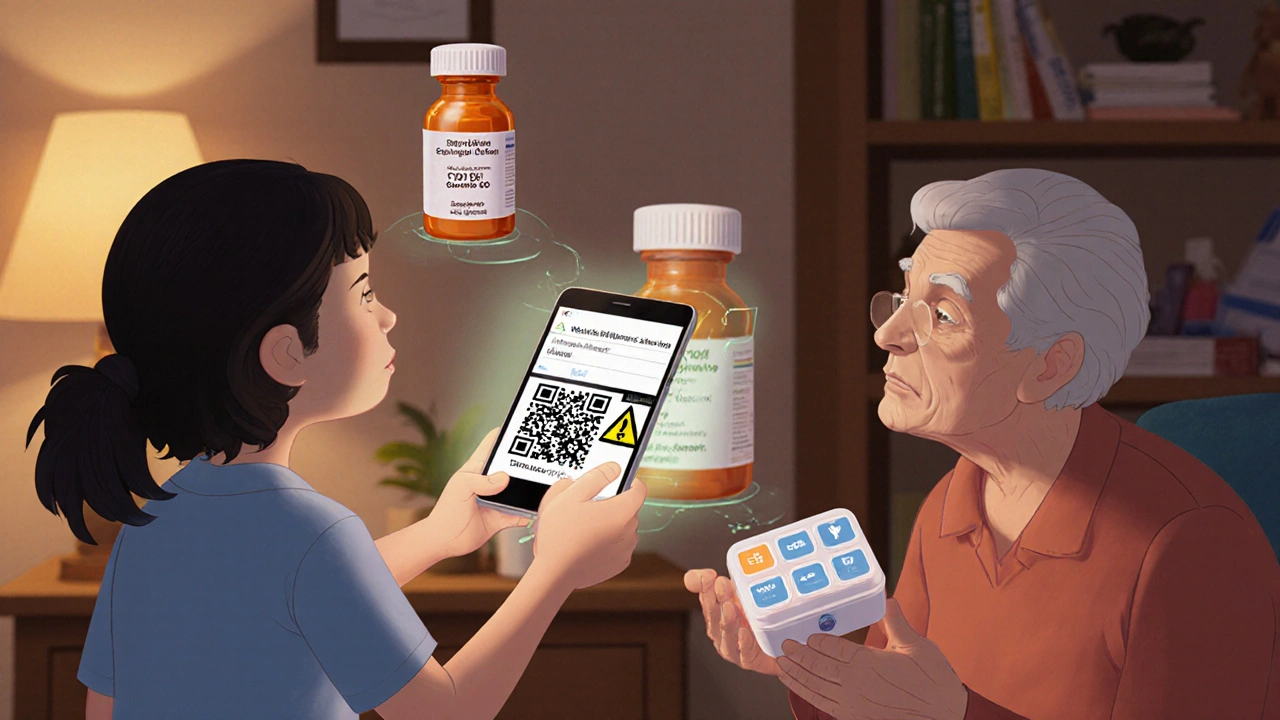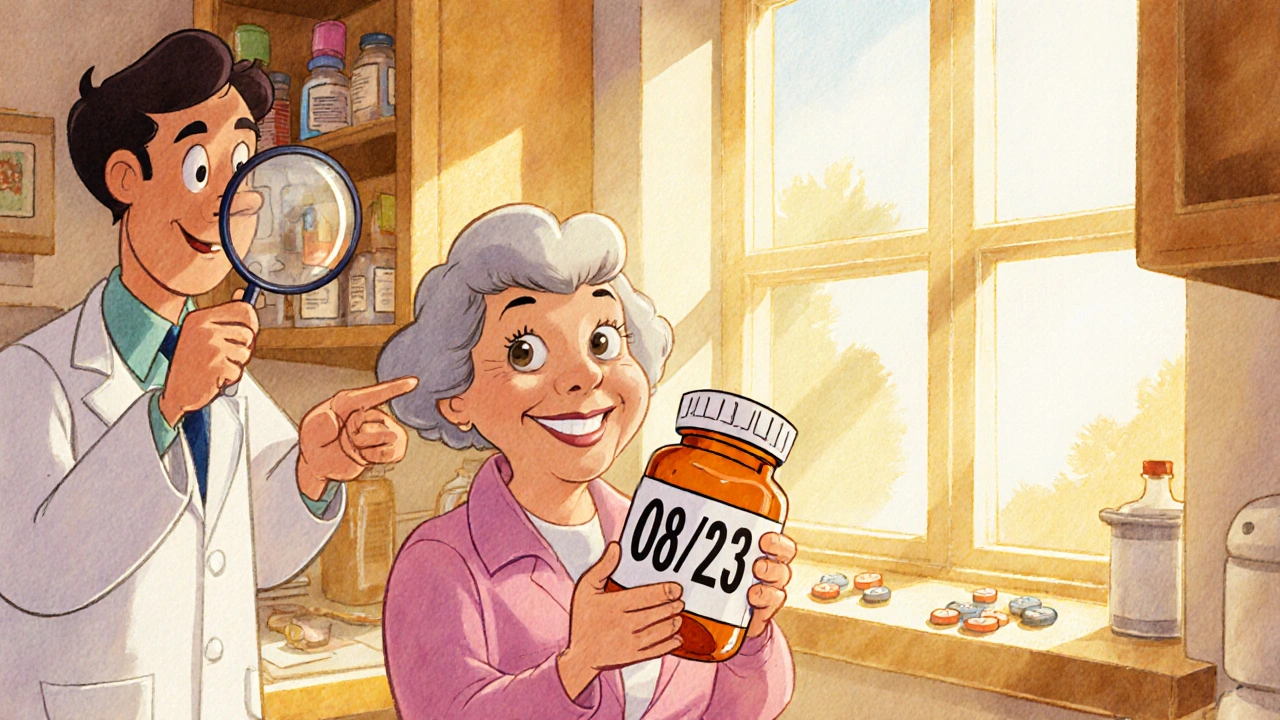Why Expiration Dates on Medication Matter
You open a medicine bottle and see a date printed on the side: 08/23. Is it safe to take? Many people assume expired meds are dangerous - but that’s not always true. The truth is more complicated. Expiration dates don’t mean the drug suddenly turns toxic. They mean the manufacturer guarantees the medication will work as intended up to that date - if stored properly.
The U.S. Food and Drug Administration (FDA) requires all prescription and over-the-counter drugs to have an expiration date. This date comes from real-world testing: labs track how the chemical makeup of a drug changes over time under heat, humidity, and light. Most drugs are tested for 1 to 5 years after production. Injections usually last 2-5 years, creams and patches 1-3 years, and eye drops often expire within 6 months to 2 years.
But here’s the catch: expiration dates are based on ideal storage. If you leave your pills in a hot bathroom or a sunlit windowsill, they can break down faster - even before the printed date.
How Expiration Dates Are Shown on Packaging
Don’t assume all expiration labels look the same. You might see any of these:
- Expiry: 08/23
- Exp: 2023-08
- Use by: August 2023
- Exp date: 08.23.2023
- Use before: 23/08/2023
In the U.S., if you see just a month and year - like 08/23 - it means the drug expires on the last day of August 2023. No need to guess. In Europe, you’ll typically see day/month/year (e.g., 23/08/2023). In China, it’s year/month/day (2023/08/23).
Always check both the original bottle and the pharmacy label. If you picked up a prescription, the pharmacy might have put on a new date - often labeled “discard after” or “do not use after.” That’s not the manufacturer’s date. That’s the pharmacy’s beyond-use date.
Manufacturer Date vs. Pharmacy Beyond-Use Date
This is where confusion starts. Let’s say your insulin was manufactured in January 2023 with an expiration date of January 2025. But your pharmacy dispensed it in June 2024 and wrote “discard after June 2025” on the label. Which one do you follow?
Here’s the rule: Always follow the earlier date. The pharmacy’s beyond-use date is often shorter because they can’t guarantee storage conditions after dispensing. For most pills, the pharmacy date is 1 year from when you got it. But for liquid antibiotics, eye drops, or insulin, it could be as short as 14 days.
Many people throw out perfectly good medicine because they trust the pharmacy label without checking the original bottle. That’s a mistake. Ask your pharmacist to write the manufacturer’s expiration date on the bottle too. That way, you know the full picture.
Which Medications Are Dangerous After Expiration?
Most pills are still safe to take a few months past their expiration date - especially if stored cool and dry. But some are not worth the risk.
- Insulin: Loses potency fast. Using expired insulin can mean dangerously high blood sugar.
- Birth control pills: Even slight loss of hormone strength can lead to unintended pregnancy.
- Thyroid meds (like levothyroxine): If the dose drops, your metabolism goes haywire.
- Anti-platelet drugs (like aspirin or clopidogrel): If they weaken, your risk of heart attack or stroke increases.
- Antibiotics: They don’t turn toxic - but they can lose strength. That means they won’t kill bacteria properly, which can lead to antibiotic-resistant infections.
There’s a myth that tetracycline turns poisonous after expiring. That was true in the 1960s with old manufacturing methods. Modern tetracycline doesn’t do this. But still - don’t take it past the date. It won’t work well.

How to Tell If a Medication Has Gone Bad
Some changes are obvious. Others aren’t.
Look for:
- Discoloration (pills turning yellow or brown)
- Cracking, crumbling, or sticking together
- Unusual smell - especially a strong vinegar or chemical odor
- Liquid meds that are cloudy, separated, or have particles floating
- Eye drops that change color or become cloudy
But here’s the scary part: Most expired meds show no visible signs of degradation. Your ibuprofen might look perfect - but if it’s been sitting in your gym bag for three years, it could be 20% weaker. That’s enough to make it useless for pain relief.
Health Canada says to check for the DIN (Drug Identification Number) or GP number on the label. That confirms it’s a legally approved product. If it’s missing, don’t take it - even if the date hasn’t passed.
Storage Is Just as Important as the Date
Expiration dates assume your meds are stored right. Most drugs are fine at room temperature - between 68°F and 77°F (20°C-25°C). But if you keep them in the bathroom, where steam and heat rise, they’ll break down faster.
Some meds need refrigeration. Check the label. Insulin, certain antibiotics, and eye drops often do. But don’t freeze them. Freezing can destroy the structure of liquid medicines.
Light matters too. Keep pills in their original amber bottles. Don’t transfer them to pill organizers unless you’ll use them within a week. Plastic containers don’t block light like glass does.
Moisture is the enemy. Don’t store pills in the kitchen near the sink. Use a cool, dry drawer or cabinet. Silica gel packets in the original bottle? Leave them in. They help absorb moisture.
What to Do With Expired Medication
Don’t flush pills down the toilet. Don’t toss them in the trash where kids or pets might find them. Don’t give them to friends.
Find a drug take-back program. Pharmacies, hospitals, and police stations often have drop boxes. In Australia, you can return expired meds to any pharmacy for safe disposal - no questions asked.
If no take-back option exists, mix pills with coffee grounds or cat litter in a sealed bag before throwing them out. That makes them unappealing and harder to misuse.

Smart Tips to Avoid Confusion
- Mark your calendar: Set a reminder 3 months before any critical med expires. That gives you time to refill.
- Use apps: Try MedSafe or MyTherapy to track expiration dates across all your meds.
- Keep original packaging: Even if you transfer pills to a weekly organizer, hold onto the bottle. That’s where the real expiration date lives.
- Ask your pharmacist: When you pick up a new prescription, ask, “Is this date the manufacturer’s or yours?”
- Check your medicine cabinet twice a year: Spring and fall are good times to sort through old bottles.
What the Future Holds
Pharmaceutical companies are starting to use smarter labels. Merck now puts time-temperature sensors on insulin pens - if the drug got too hot, the label changes color. The European Medicines Agency now requires thermochromic ink on expiration labels. And the FDA is pushing QR codes on packaging that link to real-time expiration and storage info.
Still, most people won’t see these upgrades for years. For now, the best tool you have is knowledge. Know what the date means. Know where your meds are stored. Know which ones you can’t risk.
When in Doubt, Ask
Pharmacists are trained to answer these exact questions. Don’t feel silly asking. A $200 insulin pen isn’t worth the gamble. Neither is your health.
If you’re unsure about a medication - especially if you have kidney disease, liver issues, or a weak immune system - don’t guess. Call your pharmacist. They’ll tell you whether it’s safe, or if you need a new prescription.
Can I still take medicine after the expiration date?
Most medications remain safe and effective for months or even years past their expiration date if stored properly. The FDA’s Shelf Life Extension Program found that 90% of tested drugs retained potency well beyond their printed date. However, this applies mainly to sealed, unopened products kept in cool, dry places. Never assume this applies to insulin, birth control, thyroid meds, or antibiotics - those should never be used past the date.
What does 08/23 mean on a pill bottle?
In the U.S., a date like 08/23 means the medication expires on August 31, 2023. The expiration is the last day of the month, not the first. Always check if the label says "Expiry" or "Use by" - that confirms it’s a month/year format.
Should I follow the pharmacy’s expiration date or the manufacturer’s?
Always follow the earlier date. The pharmacy’s date (often labeled "discard after") is usually shorter because they can’t control how you store the medicine after you take it home. For most pills, the pharmacy date is one year from dispensing. But for liquids like antibiotics or insulin, it can be as short as two weeks. The manufacturer’s date is the real shelf life - but only if the drug was stored correctly.
Why do some medications expire so quickly?
Liquid medications - like eye drops, insulin, or antibiotic suspensions - are more vulnerable to bacterial growth and chemical breakdown. They often contain preservatives that weaken over time. Eye drops, for example, are sterile when sealed, but once opened, they’re exposed to air and bacteria. That’s why they typically expire 28 days after opening, even if the bottle says 2 years.
Is it safe to use expired painkillers like ibuprofen?
Ibuprofen and similar OTC pain relievers are generally safe to use a few months past their expiration date if stored properly. But their potency can drop over time - meaning they may not relieve pain as well. After several years, they may become ineffective. Never use them if they’ve changed color, smell strange, or look cracked or sticky.
How should I dispose of expired medication?
Never flush pills or throw them loose in the trash. The safest way is to return them to a pharmacy or use a drug take-back program. In Australia, all pharmacies accept expired meds for safe disposal. If no program is available, mix pills with coffee grounds or cat litter in a sealed container before tossing them. This prevents misuse and keeps them out of water systems.


Connor Moizer
November 15, 2025 AT 01:02Liam Dunne
November 16, 2025 AT 12:55Jessica M
November 16, 2025 AT 21:57Sharon Campbell
November 17, 2025 AT 18:52Phil Best
November 19, 2025 AT 15:02roy bradfield
November 21, 2025 AT 09:56sara styles
November 22, 2025 AT 10:48Brendan Peterson
November 23, 2025 AT 21:51Patrick Merk
November 24, 2025 AT 09:00Parv Trivedi
November 26, 2025 AT 03:40Erika Lukacs
November 27, 2025 AT 19:16kanishetti anusha
November 28, 2025 AT 06:12Willie Randle
November 29, 2025 AT 07:03Rebekah Kryger
December 1, 2025 AT 02:42Victoria Short
December 1, 2025 AT 08:33